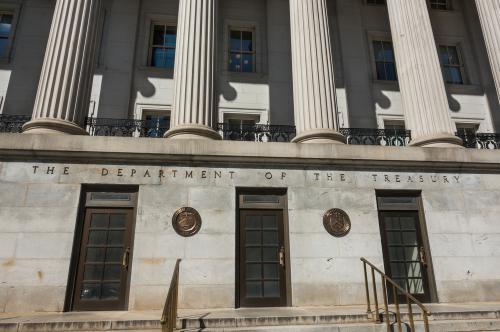Treasury nominee Timothy Geithner went before a Senate panel Wednesday, answering questions on the financial crisis as well as his tax payment controversy. Martin Baily and other analysts mull what’s ahead for Obama’s economic agenda on NewsHour.
JUDY WOODRUFF: President Obama is facing a series of tough choices quickly on a growing storm of economic troubles, including: a new round of tremors in the world of banking; a financial rescue plan that many argue has not helped the system; and a massive stimulus package.
To help us understand how all this plays into some of the president’s economic prescriptions, we turn to: Martin Baily, a senior fellow at the Brookings Institution, he was chairman of the Council of Economic Advisers during the Clinton administration; Ken Rogoff, professor of public policy and economics at Harvard University, he’s a former chief economist for the IMF; and Karen Shaw Petrou, managing partner of the consulting firm Federal Financial Analytics.
Thank you, all three.
And, Ken Rogoff, to you first. Yes, there are several different areas we’re hearing about. What are the most immediate, most pressing problems that the administration, this new administration has to deal with?
KENNETH ROGOFF, Harvard University: Well, I think the Treasury Secretary-designate Tim Geithner, you know, said it very well, that you really need to move very forcefully in a lot of directions. You need a comprehensive plan.
I think that’s why he was reluctant to let out a piece of it, because that’s really — this piecemeal approach has really been the problem.
So the banking sector is sick. We can’t have normal growth without credit flowing, without loans, without the banking sector being healthy again. It’s also true that consumption is collapsing, investment is collapsing, and we probably need heavy fiscal stimulus to fill in. We probably also need some support on the housing front, because that’s really the epicenter of this crisis.
So I think the Obama team needs to come forth very quickly with a holistic plan. They’ve given us a lot of pieces of it, especially the fiscal stimulus. They’ve been very cautious about saying anything about the banking sector, I think for fear of sparking a panic before they’re in place to deal with it. Now they are.
JUDY WOODRUFF: Karen Petrou, I think it is the case that we haven’t heard as much, until just the last few days, about the banking sector. What is the problem there? Help us understand.
KAREN SHAW PETROU, Federal Financial Analytics: The problem is a loss of confidence. And we keep going through that, and then the capital markets take some comfort in a policy, and then the policy changes. We’ve been bouncing around from asset purchases to capital injections to several new ideas on the table now, even as we’ve seen some of the mainstays of the U.S. financial system — and, in fact, the global system — falter.
So that’s really at the heart of this lack of confidence, in part because we’ve still got a world of hurt and all the losses, particularly in the mortgage sector, yet to come.
JUDY WOODRUFF: Martin Baily, why didn’t we know this earlier? Or did we and people weren’t talking about it?
MARTIN BAILY, Brookings Institution: Well, I think some of it maybe wasn’t revealed. Maybe the banks knew more than they were letting on. And certainly in Europe, we know that the banks have not necessarily been forced to mark their assets to market, so we don’t know some of the problems there.
I think also, as the economy deteriorates and we get bigger losses than we expected — and the economy is deteriorating, I think, faster than anyone thought even six months ago — so as the unemployment rate rises and people lose their jobs, then we see more defaults on credit cards, we see further defaults on mortgages, and that takes capital away from the banks and makes it difficult for them to lend.
In fact, they are really forced to call back some of those loans, sell off some of their assets. And it’s that process, so-called deleveraging, that we want it stop by putting capital into the banks and potentially by buying some of the assets that are troubled that the banks have right now.
The Brookings Institution is committed to quality, independence, and impact.
We are supported by a diverse array of funders. In line with our values and policies, each Brookings publication represents the sole views of its author(s).



Commentary
Banking Sector, Bailout Reform May Top Obama Economic Agenda
January 21, 2009